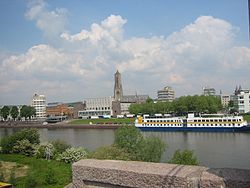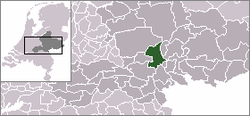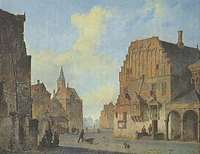Arnhem
Arnhem
Èrnem | |
|---|---|
Municipality | |
 City view | |
 | |
| Country | Netherlands |
| Province | Gelderland |
| Government | |
| • Mayor | P.C. Krikke (VVD) |
| • Aldermen | B. van Eeten W.J.C. Hoeffnagel C. Jansen R.H. Kreeft |
| • Secretary | S. Gerritsen |
| Area | |
| • Total | 101.53 km2 (39.20 sq mi) |
| • Land | 98.14 km2 (37.89 sq mi) |
| • Water | 3.39 km2 (1.31 sq mi) |
| Population (1 May 2009) | |
| • Total | 146,095 |
| • Density | 1,489/km2 (3,860/sq mi) |
| Source: CBS, Statline | |
| Time zone | UTC+1 (CET) |
| • Summer (DST) | UTC+2 (CEST) |
| Postal codes | 6811 - 6846 |
| Area code | 026 |
| Website | www.arnhem.nl |
Arnhem () (South Guelderish: Èrnem) is a city and municipality, situated in the eastern part of the Netherlands. It is the capital of the province of Gelderland and located near the river Nederrijn as well as near the St. Jansbeek, which was the source of the city's development. Arnhem has 146,095 residents (per 30 June 2009) as one of the largest cities in the Netherlands. The municipality is part of the city region Arnhem-Nijmegen, a metropolitan area with 728,500 inhabitants. Arnhem is home to the Hogeschool van Arnhem en Nijmegen.
History
The earliest history of Arnhem
Arnhem was first mentioned as such in 893 as Arneym or Arentheym, referring to the many eagles that inhabited the hills and forests of Arnhem back then. Traces of human residence date back much further, however.
The oldest archeological findings of human activity around Arnhem are two firestones of about 70.000 years ago. This comes from the stone age, when the Neanderthals lived in this part of Europe. In Schuytgraaf, tracks of a hunter's camp have been discovered from around 5000 BC. In Schaarsbergen, 12 grave hills were found from 2400 BC, which brought the so-called Neolithic revolution to the area of Arnhem, i.e. the rise of the farmers.
The earliest settlement in Arnhem dates from 1500 BC, where traces have been found on the Hoogkamp, where the Van Goyenstraat is currently located. In the inner city, around the St. Jansbeek, traces of settlement have been found from around 700 BC, while the first traces south to the Rhine have been found dating around 500 BC, in the Schuytgraaf.
Though the early tracks of settlements did show that the early residents of Arnhem descended from the forests on the hills, Arnhem was not built on the banks of the river Rhine, but a little higher along the St. Jansbeek. Arnhem arose on the location where the road between Nijmegen and Utrecht/Zutphen split. Seven streams provided the city with water, and only when the flow of the Rhine was changed in 1530, was the city located at the river.

History of the city of Arnhem
The city of Arnhem had its real origins in 1233 when Otto II, count of Guelders from Zutphen, conferred city rights on the town, which had belonged to the abbey of Prüm, settled in, and fortified it. Arnhem entered the Hanseatic League in 1443. In 1473, it was captured by Charles the Bold of Burgundy. In 1514, Charles of Egmond, duke of Guelders, took it from the dukes of Burgundy; in 1543, it fell to the emperor Charles V. As capital of the so-called "Kwartier van Veluwe" it joined the Union of Utrecht in 1579 and became part of the Republic of the Seven United Provinces of the Netherlands in 1585. The French occupied the town 1672–74; from 1795 to 1813, it was reoccupied by the French, by both revolutionary and imperial forces. In the early 19th century, the former fortifications were almost completely dismantled, to give space for town expansion. The Sabelspoort (Sabresgate) is the only remaining part of the medieval walls.
In the 19th century, Arnhem was a genteel resort town famous for its picturesque beauty. It was known as "het Haagje van het oosten" (The Little Hague of the East), mainly because a number of rich former sugar barons or planters from the Indies settled there, as they did in The Hague. Even now the city is famous for its parks and greenery. The urbanization in the north on hilly terrain is also quite unusual for the Netherlands.
The Battle of Arnhem

In World War II, during Operation Market Garden (September 1944), the British 1st Airborne Division and the Polish 1st Independent Parachute Brigade were given the task of securing the bridge at Arnhem. The units were parachuted and glider-landed into the area on 17 September and later. The bulk of the force was dropped rather far from the bridge and never met their objective. A small force of British 1st Airborne managed to make their way as far as the bridge but was unable to secure both sides. The Allied troops encountered stiff resistance from the German 9th and 10th SS Panzer divisions, which had been stationed in and around the city.
The British force at the bridge eventually surrendered on 21 September, and a full withdrawal of the remaining forces was made on 26 September. These events were dramatized in the 1977 movie A Bridge Too Far. (The bridge scenes in the movie were shot in Deventer, where a similar bridge over the IJssel was available, as the area around Arnhem bridge had changed too much to represent WWII era Arnhem). As a tribute, the rebuilt bridge was renamed 'John Frost-bridge' after the commander of the paratroopers. The official commemoration is 17 September.
The current bridge is the third almost-identical bridge built at the same spot. The Dutch Army destroyed the first bridge when the Germans invaded Holland in 1940. The second bridge was destroyed by the US Army Air Forces shortly after the 1944 battle.
A second battle of Arnhem took place in April 1945 when the city was liberated by I Canadian Corps of the First Canadian Army.
Although it is generally said, as above, that the British Force at the Northern end of the Arnhem bridge surrendered, General John Frost, who as a Lt Col commanded that force, fiercely denied that. He and his men were overwhelmed and were captured.
Names of Arnhem
Through the ages, the area of Arnhem has been known by various names, both official and unofficial.
- Arnhem
The name Arnhem comes from Arneym, much earlier Arentheem, and originally derived from Latin Arenacum. The Dutch name literally means "home of the eagle" (arend means eagle in Dutch) and stems from the many eagles that used to inhabit the hills and the woods of Arnhem. The name Arneym is first mentioned in 893 by the monastery Sint-Salvatorabdij. The name Arenacum, the first mention of the area which became known as Arnhem, comes from the Roman era and means "with eagles".
- Èrnem
Èrnem is the name of the city in the local dialect, South Guelderish. In everyday life, the name is not often used by the inhabitants of Arnhem, who seldom speak with the Arnhemian accent/dialect any more. This accent is now mainly confined to the working class areas.
- Arnheim
Arnheim is the German name for Arnhem; it more clearly refers to the origin of the name (heim = home).
Hague of the East (Haagje van het Oosten in Dutch)
In the second half of the 19th century, Arnhem was an elitist city and therefore was sometimes called The Hague of the east of the Netherlands.
Green city on the Rhine or Park City
The image of Arnhem on the Rijn, with green forests in the background, has always been a much-loved theme of painters. Besides that, Arnhem has many parks. This has earned Arnhem the name Green city on the Rhine (from the 17th century) or Park City (from the 19th century).
- Meginhardeswich
Around 814 there is a written reference to Meginhardeswich, which is now, as the present-day Meijnerswijk, part of Arnhem. In 847 it was plundered by the Vikings.
- Oppidium Arnoldi Villa
When the Romans came to the Netherlands c. 50 BC, the area around was called Oppidium Arnoldi Villa. The settlement itself was called Arenacum.
Population centres
The municipality of Arnhem consists of the city of Arnhem and the following surrounding suburbs and former villages:
- Elden (Netherlands) (former village, now totally surrounded by other Arnhem neighbourhoods )
- Schaarsbergen
Places of interest
The Groote Kerk (St. Eusebius), built 1452–1560, lost most of its tower during World War II, of which a part has been reconstructed to a modern design and opened in 1964. Officially the tower is not part of the church and is owned by the municipality.
The house of Maarten van Rossum, a general serving Duke Charles van Gelre, has been the town hall since 1830: The satyrs in its Renaissance ornamentation earned it the name Duivelshuis ("devil's house").
The National Heritage Museum (Nederlands Openluchtmuseum) is located outside the city. It is an open air museum and park with antique houses, farms, and factories from different parts of the Netherlands.
Burgers' Zoo is one of the biggest and most-visited zoo in the Netherlands, featuring an underwater walkthrough, desert, mangrove, rainforest, etc.
The Gelredome, the home field of Vitesse, the city's Eredivisie side in football, is a unique facility that features a retractable roof and a slide-out grass pitch. The concept has been fully duplicated since then by Veltins-Arena in Gelsenkirchen, Germany, and University of Phoenix Stadium in Glendale, Arizona, US, and partially by the Sapporo Dome in Japan (which has a sliding pitch but a fixed roof).
The KEMA Toren (formerly known as SEP Control Tower) is the highest structure of the town. It is a 140-m-high TV tower.

Transport
Arnhem has a main railway station - Arnhem railway station, which is serviced by several intercity lines and the ICE to Düsseldorf and further on to Frankfurt. Nowadays there are also trains departing all the way to Moscow, by NS HiSpeed. But only one train part makes it all the way to Moscow. The intercity lines provide direct connections to Utrecht, Nijmegen, and Zutphen. It is also the terminus for several local railway services. Arnhem has three other stations, namely Arnhem Velperpoort, Arnhem Presikhaaf, and Arnhem Zuid.
Arnhem is unique in the Netherlands with its trolleybus system.
Notable people
- See also People from Arnhem
- Arnhem was the birthplace of physicist and Nobel Prize laureate Hendrik Lorentz in 1853.
- The English poet Sir Philip Sidney died in 1586 in Arnhem.
- The film comedienne Truus van Aalten was born in Arnhem in 1910.
- Dutch/British actress Audrey Hepburn attended Arnhem Conservatory during the war years 1939–45.
- Dutch water polo player Rik Toonen, winner of Olympic bronze in 1976, was born in Arnhem.
- Cirque du Soleil artist (Love, 2006) Goos Meeuwsen was born in Arnhem.
- Graphic artist M. C. Escher moved to Arnhem when he was five and spent most of his youth there.
Facts and Figures
- Arnhem is the name of a march composed by A.E. Kelly.
- Arnhem Land in Australia is named after the VOC-ship Arnhem.
- Arnhem is twinned with the London Borough of Croydon and Wuhan, China.
Climate
| Climate data for Arnhem, Netherlands | |||||||||||||
|---|---|---|---|---|---|---|---|---|---|---|---|---|---|
| Month | Jan | Feb | Mar | Apr | May | Jun | Jul | Aug | Sep | Oct | Nov | Dec | Year |
| Source: knmi.nl (Klimaatatlas van Nederland, normaalperiode 1971–2000, ISBN 90389 1191 2)[1] | |||||||||||||
See also
References
Notes
- ^ (Temperature data 270 DEELEN, Precip data 541 ARNHEM) | accessdate = October 2008
External links
- Municipality Official website (English version)
- VVV Arnhem Tourist Office (English version)
- Arnhem Nijmegen Cool Region City Region Arnhem Nijmegen (English version)
- Pictures of Arnhem
- Webcam
- Arnhem in Site Virtual City Tour (English version).
- Webcam Willemsplein



